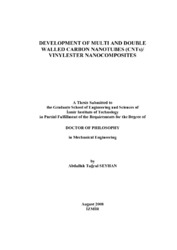Please use this identifier to cite or link to this item:
https://hdl.handle.net/11147/3520| Title: | Development of Multi and Double Walled Carbon Nanotubes (cnts) / Vinylester Nanocomposites | Authors: | Seyhan, Abdullah Tuğrul | Advisors: | Tanoğlu, Metin | Publisher: | Izmir Institute of Technology | Abstract: | This study focuses on development and characterization of thermosetting resin based nanocomposites containing multi and double walled carbon nanotubes with and without amine functional groups (MWCNT, DWCNTs, MWCNT-NH2 and DWCNTNH2).A novel 3-roll milling technique was conducted to prepare the resin suspensions with carbon nanotubes (CNTs). Rheological measurements performed on the resin suspensions showed that addition of very low contents (0.05, 0.1 and 0.3 wt. %) of MWCNTs and MWCNT-NH2 affected the flow characteristic of the resin, significantly.Further, the curing behavior of a vinylester-polyester hybrid resin suspensions containing 0.3 wt % of MWCNTs and MWCNT-NH2 was intensively studied. It was found that regardless of amine groups, presence of CNTs affected the polymerization of the hybrid matrix resin. Final individual fractional conversion rates of styrene and vinylester monomers were found to be vastly dependent on the type of CNTs. Glass transition temperature (Tg) values of the nanocomposites with MWCNTs and MWCNTNH2 were found to increase with filler content. Moreover, nanocomposites containing MWCNTs and MWCNT-NH2 were found to possess higher tensile strength, elastic modulus as well as fracture toughness and fracture energy as compared to the neat hybrid resin. On the other hand, electrical properties of the nanocomposites were also investigated and it was found that nanocomposites with MWCNTs exhibited the lowest percolation threshold value. In addition, nanocomposites with amino functionalized CNTs were found to exhibit lower electrical conductivity as compared to those with untreated CNTs. Nanocomposites with AC electric field induced aligned CNTs were also prepared. Finally, based on the findings obtained for CNT/ resin suspensions, as a case study, electrically conductive glass fiber reinforced composite laminates were successfully produced, using the CNT modified resin suspensions as matrix material, via Vacuum Assisted Resin Transfer Molding (VARTM) and Resin Transfer Molding (RTM) methods. | Description: | Thesis (Doctoral)--Izmir Institute of Technology, Mechanical Engineering, Izmir, 2008 Includes bibliographical references (leaves: 174-185) Text in English; Abstract: Turkish and English xx, 185 leaves |
URI: | http://hdl.handle.net/11147/3520 |
| Appears in Collections: | Phd Degree / Doktora |
Files in This Item:
| File | Description | Size | Format | |
|---|---|---|---|---|
| T000677.pdf | DoctoralThesis | 7.83 MB | Adobe PDF |  View/Open |
CORE Recommender
Page view(s)
260
checked on May 12, 2025
Download(s)
90
checked on May 12, 2025
Google ScholarTM
Check
Items in GCRIS Repository are protected by copyright, with all rights reserved, unless otherwise indicated.